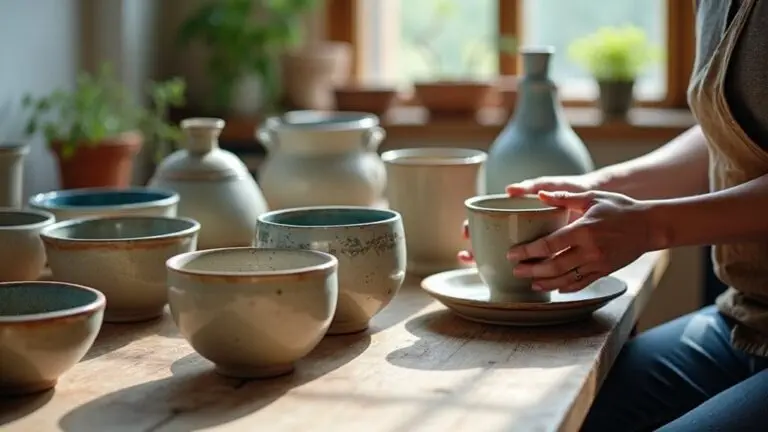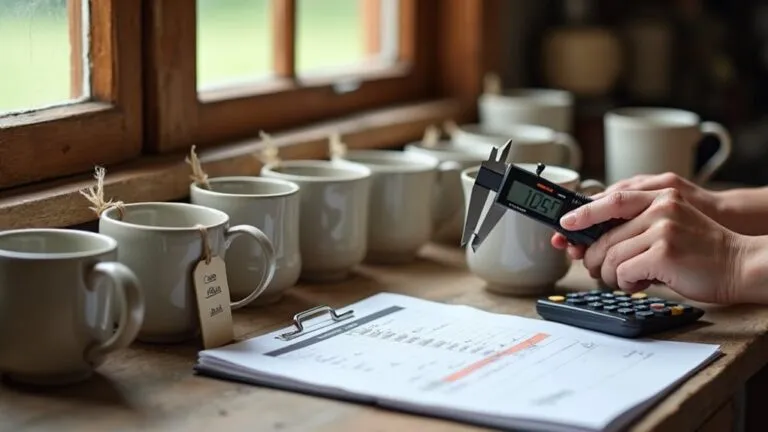You'll find handmade pottery prices typically range from $30 to $500 per piece, reflecting the significant time and skill invested in each creation. When you're shopping for pottery, expect to pay around $30-50 for functional pieces like mugs or small bowls, while larger or more intricate items can cost hundreds. These prices account for materials ($5-6 per piece), skilled labor (3-8 hours per item), and studio overhead costs. Professional potters invest thousands in equipment and spend years perfecting their craft, with each unique piece passing through multiple hands and firing stages. Understanding what goes into creating these pieces will help you appreciate their true value.
Raw Materials and Supply Costs

Three essential components drive the raw materials and supply costs in handmade pottery: clay, glazes, and firing materials. You'll find that raw material pricing starts at about $0.50 per pound for clay, while glazes typically run around $2 per piece.
Don't forget about those firing costs – they're vital to your final product! The total materials, glaze, and firing add up to $5.74 per piece.
When you're managing your pottery supply chain, you'll need to factor in everything from eco-friendly packing materials to kiln maintenance.
Here's a fun fact: a single bowl's material costs break down to about $2.60, but that's before you've even turned on the kiln!
Whether you're working with standard earthenware or specialty clay bodies, your material choices will greatly impact your final costs, so it's smart to plan your supplies in batches.
Pottery Equipment and Studio Expenses
Setting up your pottery studio starts with a significant investment in a kiln, which you'll need to budget $200-$5,000 for, depending on whether you choose a compact tabletop model or a spacious professional unit.
A reliable electric pottery wheel will cost between $300 to $1,500, making it another major equipment consideration.
You'll also want to factor in kiln furniture costs of $10-$100+, plus essential firing supplies that'll keep your kiln running smoothly.
While these initial expenses might make your wallet wince, remember that a well-equipped studio will serve as your creative sanctuary for years to come, with monthly operating costs varying based on how often you're firing up that kiln and creating new pieces.
Essential Kiln Setup Costs
When establishing a pottery studio, you'll need to budget for essential kiln setup costs that typically range from $1,500 to over $10,000, depending on your chosen equipment and scale of operation.
Your kiln selection will be a game-changer, with options spanning from compact tabletop models at $200 to professional powerhouses reaching $20,000. The Amaco Excel Kiln offers an economical yet high-quality option at around $4,270.
Don't forget to factor in those must-have accessories that'll keep your kiln running smoothly.
You'll want to invest in proper kiln maintenance tools and energy efficiency features to save money in the long run.
Budget for kiln furniture like shelves and supports ($10-$100+), temperature controls ($100-$500), and heat-resistant materials ($20-$100).
While these numbers might seem intimidating, remember that quality equipment is an investment in your creative future.
Monthly Studio Operating Expenses
Running a pottery studio involves substantial monthly operating expenses that can range from $2,500 to $15,000 or more.
You'll need to plan for recurring costs like rent ($1,000-$5,000), utilities ($200-$800), and those ever-present studio maintenance needs ($100-$500).
Cost management becomes essential when you factor in materials, which can add up quickly. You're looking at $100-$500 for clay, $50-$300 for glazes, and don't forget about those shipping fees that'll set you back $50-$600 monthly. Implementing energy-efficient practices in your studio can help reduce utility costs by up to 30%.
If you're planning to hire staff, that's another significant expense – employee wages typically range from $2,000 to $10,000 monthly.
Smart budgeting is key, and you might want to start small and scale up as your pottery business grows.
Labor and Time Investment
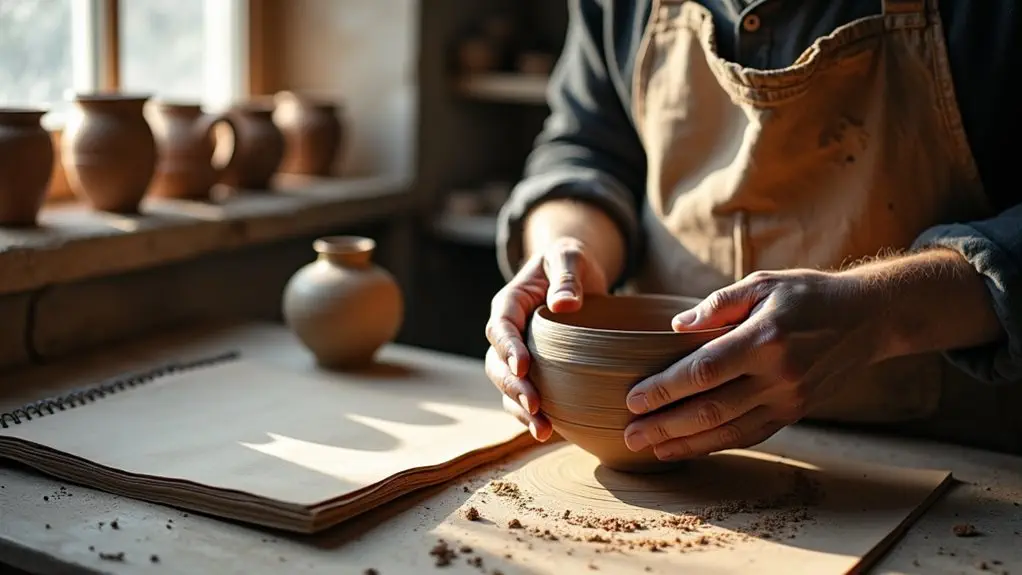
When you're investing in handmade pottery, you're not just paying for a beautiful piece – you're supporting the countless hours of skilled craftsmanship that went into creating it.
The time investment for each handmade pottery piece can range from several hours to several days, including steps like clay preparation, throwing, trimming, and multiple firing sessions. Artisans must carefully monitor their utilities and equipment to ensure each firing achieves the desired results. The unique variations in color and design due to handmade nature also contribute to each piece's individuality.
Your appreciation for handmade pottery's value grows even deeper when you consider that pottery masters spend years perfecting their techniques, making each piece a demonstration of their expertise and dedication.
Skilled Craftsmanship Hours
Creating handmade pottery demands a significant investment of skilled labor and time, which directly impacts the final cost of each piece. When you're paying for handmade pottery, you're investing in hours of skilled techniques and dedicated craftsmanship pricing that reflects true artisan value.
A single piece can take anywhere from 3 to 8 hours to complete, depending on its complexity. For instance, time studies show that tasks like throwing, pulling handles, and glazing each require careful tracking to determine accurate production times.
You'll find that professional potters often charge between $25 and $75 per hour for their expertise, and it's worth every penny. Their time includes not just the actual throwing of the pot, but also the careful preparation of materials, glazing, firing, and even the years they've spent perfecting their craft.
It's like paying for a symphony of movements that transform raw clay into functional art.
Production Time Per Piece
The production timeline for handmade pottery extends far beyond the skilled craftsmanship hours, breaking down into distinct stages that add up to significant time investments.
When you're looking at production efficiency, each piece requires about 4 minutes for material prep, 7 minutes for throwing and shaping, plus essential drying periods that can't be rushed. With over 24 hands touching each piece during the production process, quality control is paramount.
Time management becomes vital as you factor in multiple firing stages that take 24-48 hours each, not to mention the meticulous glazing process.
You'll find that the total hands-on time for a single piece, including packaging and administrative tasks, adds up to roughly 30 minutes – and that's before considering the waiting periods between stages.
It's no wonder each handcrafted piece carries such value; there's a whole day's journey in every mug!
Value of Expertise
Professional potters invest years mastering their craft, which directly impacts the pricing of handmade pottery.
When you're looking at that beautifully crafted bowl, you're not just paying for the 25 minutes it took to make it – you're investing in decades of expertise value and refined techniques.
Continuous education through online glazing courses and workshops helps potters maintain and improve their skills.
Consider this: at an hourly rate of €40, which reflects a potter's extensive experience, creating a single bowl costs about €16.60 in labor alone.
Your pricing strategy needs to account for countless hours spent perfecting techniques, attending workshops, and learning from mistakes.
Think of it like a chef who's mastered the perfect soufflé – it's not just about the ingredients, it's about the years of practice that guarantee it rises perfectly every time!
Market Value and Price Points
Understanding market value and price points for handmade pottery involves three key dynamics: market demand, competition, and customer perception.
When you're exploring the market, you'll notice that current trends show a healthy 3.7% growth rate, which means there's increasing appreciation for handcrafted ceramics.
You'll find that pricing psychology plays a significant role in how pottery is valued. While some pieces might fetch premium prices in upscale galleries, others may need competitive pricing at local markets. Many potters use a base pricing model of $12 per pound of wet clay as a starting point.
The key is knowing where your work fits in the market ecosystem. If you're shopping for handmade pottery, you'll typically see functional pieces starting at $30-50, while more elaborate or artistic pieces can command hundreds or even thousands, depending on the potter's reputation and the piece's complexity.
Production Process Cost Breakdown
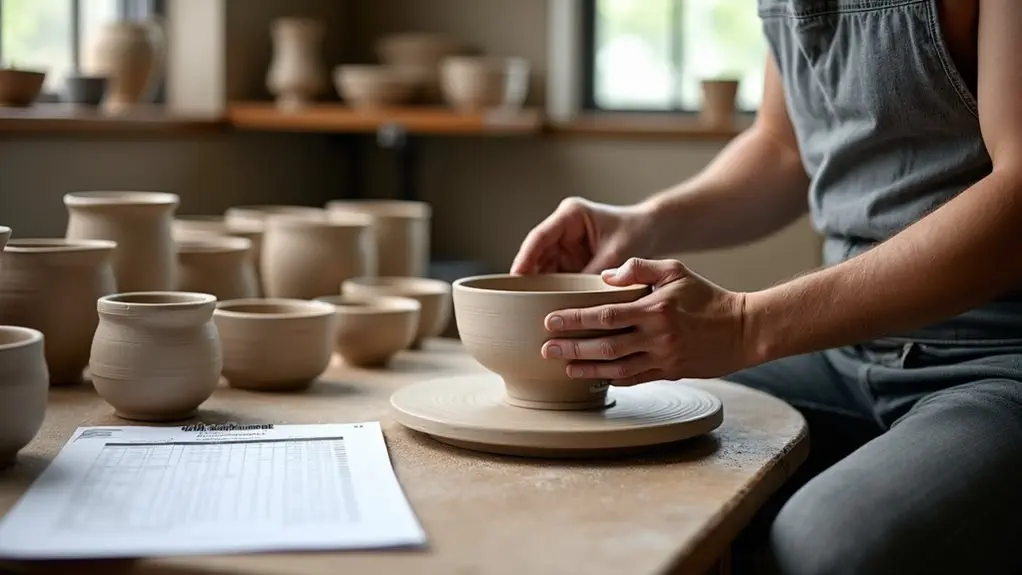
Breaking down production costs reveals the true investment behind each handmade pottery piece.
When you're diving into cost analysis, you'll find that each bowl requires about €0.60 for clay, €2 for glaze, and €0.35 for firing and kiln maintenance. The real eye-opener? Labor costs clock in at €16.60 per bowl, based on the 25 minutes it takes to create each piece.
Your pricing strategy needs to account for more than just materials and time. Starting with second-hand equipment can help manage initial production expenses.
You're looking at equipment investments that'll make your eyes pop – from €2,000 electric kilns to €25,000 gas models. Don't forget those sneaky extras like special glazes and tools!
When you add it all up, you'll understand why that beautiful handmade bowl isn't just about the clay – it's about the significant investment in craft and expertise.
Business Overhead and Operating Costs
Running a pottery studio involves substantial overhead costs that'll impact your bottom line. To maximize your operating efficiency, you'll need to conduct a thorough overhead analysis that considers both fixed and variable expenses.
Equipment depreciation costs should be carefully calculated over multiple years of use. Think of these costs as the foundation that keeps your creative space running smoothly.
Here's what you'll typically need to budget for:
- Monthly rent and utilities ranging from $1,700 to $6,000
- Initial studio setup costs between $5,000 and $10,000 for basic equipment
- Annual maintenance expenses of $1,000 to $5,000
- Marketing budget of $2,000 to $10,000 per year
- Employee wages and benefits averaging $30,000 to $60,000 annually
These numbers might seem intimidating, but they're essential investments in your pottery business's success.
Smart planning and efficient resource management can help you balance these costs while maintaining profitability.
Retail Versus Wholesale Pricing
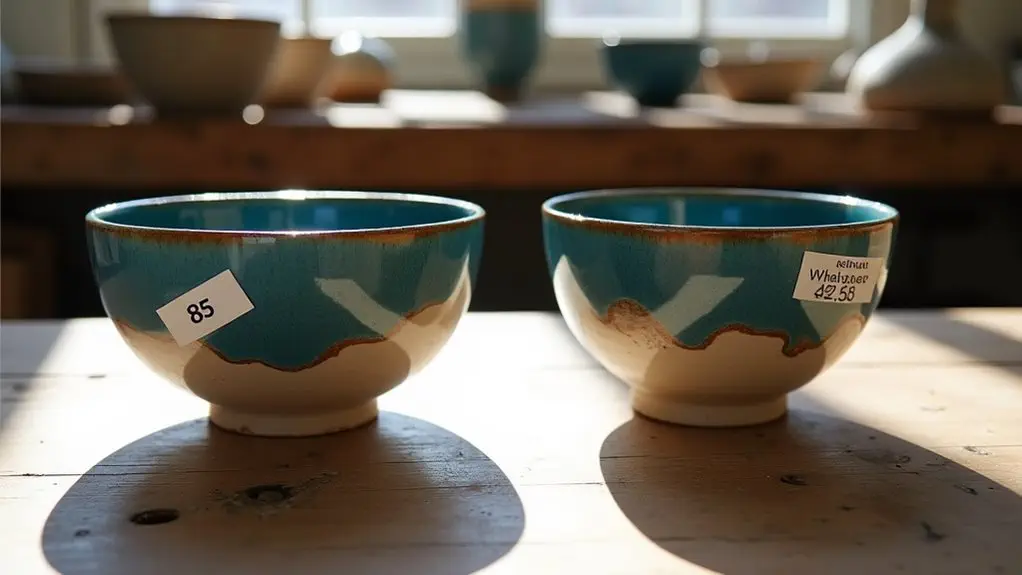
With your studio costs mapped out, the next step is setting the right prices for your pottery pieces.
Artistic value and quality heavily influence customer purchase decisions. You'll need to develop distinct retail strategies for different sales channels while ensuring your wholesale adjustments keep you profitable.
Here's the golden rule: your retail price should typically be double your wholesale price.
For example, if you're planning to sell a handmade mug for $30 retail, your wholesale price would be $15.
When you're selling through consignment, you might adjust these numbers – maybe keeping 70% while the shop takes 30%.
Remember, your pricing needs to work across all channels, from local galleries to online platforms like Etsy.
Don't forget to factor in shipping costs and minimum order quantities for wholesale accounts to protect your bottom line.
Distribution and Sales Channels
Successfully distributing your pottery requires a strategic mix of sales channels to maximize reach and revenue.
Today's innovative sales strategies combine both online and in-person opportunities, with multi-channel approaches showing potential growth of up to 40%. You'll want to engage customers where they're most comfortable shopping, whether that's through e-commerce platforms or local boutiques. Analysis shows that customers are willing to spend 20-30% more on handmade pottery that emphasizes sustainable production methods. This is particularly true for unique pieces like the Butterfly Ring Holder that appeal to those who appreciate distinctive design elements.
- Set up shop on platforms like Etsy or Amazon Handmade for 24/7 sales
- Partner with local retailers to showcase your work in physical stores
- Participate in craft fairs for direct customer engagement
- Host workshops to build community and attract new buyers
- Leverage social media to drive traffic and boost brand awareness
Final Thoughts
As they say, "You get what you pay for," and handmade pottery's value reflects the artisan's dedication, skill, and resources invested. You'll find that quality handmade pieces typically range from $20 to $300+, depending on size, complexity, and the potter's expertise. Whether you're buying a simple mug or an elaborate vase, remember that you're not just paying for clay – you're investing in someone's artistic journey and countless hours of craftsmanship.

